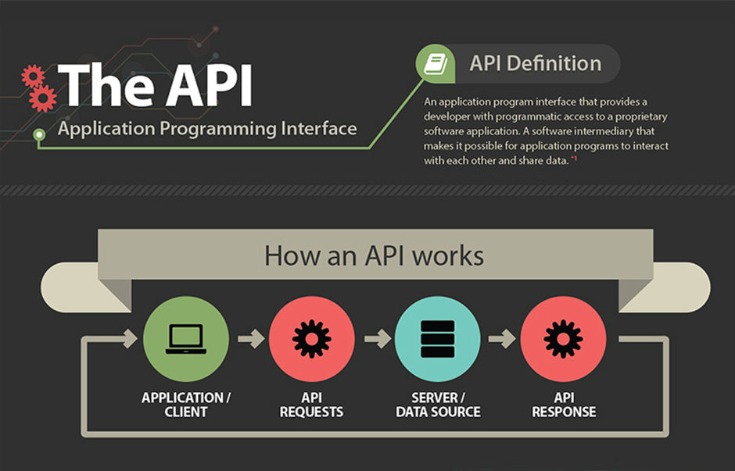What is an API? Full Form, Meaning, Definition, Types & Example

While these APIs weren’t as intrinsically linked to revenue as their commercial predecessors, they nevertheless provided significant value to their organizations. For instance, Facebook launched version 1.0 of its API in August of 2006, which allowed developers to access Facebook users’ friends, photos, events, and profile information. This API played a crucial role in establishing Facebook as one of the most popular social networks in the world. An API Gateway is an API management tool for enterprise clients that use a broad range of back-end services.
Unless you write every line of code from scratch, you will interact with external software components, and each of these will have its own API. Even if you do write all of your code from scratch, a well-designed application should have internal APIs to help organize the code and make its components more reusable. APIs are used extensively in the technology industry, as they are the primary building blocks of applications and other digital services. Financial institutions also rely on APIs to facilitate their customers’ transactions, and healthcare providers use APIs to manage patient data and keep it secure.
Types of APIs
AWS AppSync offers fully managed GraphQL API setup, administration, and maintenance, with high-availability serverless infrastructure built-in. You pay only for what you use with no minimum fees or mandatory service usage. API specifications, like OpenAPI, provide the blueprint for your API design. It is better to think about different use cases in advance and ensure the API adheres to current API development standards. One purpose of APIs is to hide the internal details of how a system works, exposing only those parts that a programmer will find useful, and keeping them consistent even if the internal details change later. An API may be custom-built for a particular pair of systems, or it may be a shared standard allowing interoperability among many systems.
It is not intended to be used directly by a person (the end user) other than a computer programmer who is incorporating it into the software. An API is often made up of different parts which act as tools or services that are available to the programmer. A program or a programmer that uses one of these parts is said to call that portion of the API.
How do APIs work?
Webhooks are lightweight callback functions that facilitate event-driven communication between APIs. In the traditional request-response cycle, an API client actively sends a request to an API server in order to retrieve data or perform actions. In contrast, a webhook listens for a specific event, such as a new user account being created or a payment being made, and performs a pre-configured action in response. This eliminates the need for the API client to poll the server, as the server will automatically perform the appropriate action or return the relevant data when the specified event occurs. APIs work by sharing data between applications, systems, and devices. The request is sent to the API, which retrieves the data and returns it to the user.
- API also does the same by taking your request, and just like the waiter tell the system what you want and give a response back to you.
- This helps reduce the amount of code developers need to create, and also helps create more consistency across apps for the same platform.
- API endpoints are the points where the client and server communicate, and where the API receives resource requests.
- These apps also use other APIs and features to provide users with directions, speed limits, points of interest, traffic warnings and more.
A microservices architecture essentially uses remote APIs for activities that were traditionally done by local API. A microservices architecture decomposes an application into components that are remotely available. Programming paradigms like object oriented programming and functional programming take different approaches to facilitating the development of good APIs. Object-oriented programming encourages strong encapsulation, whereas functional programming exposes functionality to facilitate code flow.
Document the API
Expert API designers may assess and test a new API before adding it to their directory. API testing is the same as software testing and must be done to prevent bugs and defects. API testing tools can be used to strength test the API against cyber attacks.
Developers typically use Web APIs to query a server for a specific set of data from that server. The average enterprise uses almost 1,200 cloud applications (link resides outside ibm.com), many of which are disconnected. what is api in simple words APIs enable integration so that these platforms and apps can seamlessly communicate with one another. Through this integration, companies can automate workflows and improve workplace collaboration.
What is the difference between service-oriented architecture (SOA) and microservice architecture?
There’s an API for that, too, so you don’t have to test every different Android manufacturer’s fingerprint sensor. If you want to embed a web browser to show one or more web pages, for example, you don’t have to program your own web browser from scratch just for your application. You use the WKWebView API to embed a WebKit (Safari) browser object in your application. The API development process can vary widely according to the API’s purpose, language, and scope. Nevertheless, every new API will need to be designed, implemented with an API development framework, and thoroughly tested to ensure it’s working as expected. The API client sends the request to the API server, which is responsible for handling authentication, validating input data, and retrieving or manipulating data.
If the request is more complex, spanning multiple resources, for example, the client must submit separate requests for each resource. These private APIs aren’t available for users outside of the company. Instead, organizations use them to improve productivity and communication across different internal development teams. Used to enable data and functionality transfer over the internet using HTTP protocol. Used to define how apps use operating system services and resources.
APIs also create new monetization opportunities for businesses, such as the productization of data with customized packages and plans for business partners. The software that wants to access the features and capabilities of the API is said to call it, and the software that creates the API is said to publish it. He founded PCWorld’s “World Beyond Windows” column, which covered the latest developments in open-source operating systems like Linux and Chrome OS. Beyond the column, he wrote about everything from Windows to tech travel tips. With over a decade of writing experience in the field of technology, Chris has written for a variety of publications including The New York Times, Reader’s Digest, IDG’s PCWorld, Digital Trends, and MakeUseOf.
You don’t know exactly how the restaurant prepares that food, and you don’t really need to. Another observation is that APIs exist at different levels of a program and contain each other. Learn about five different approaches to becoming API-first, then pick your favorite to remain competitive in today’s digital landscape.
APIs in object-oriented and functional programming
Across all platforms and languages, there are different ways to control what is visible and how it is used by client code. API design pays much attention to the idea of information hiding, which is the linchpin of maintainable software. All but the most trivial programs consist of language-level expressions and constructs (like ifs, loops, and operators) used in conjunction with calls to the APIs found in other packages. In turn, each program is also a component that can potentially be included and used by other programs. In order to work, the JavaScript program requires access to the browser’s capabilities.



